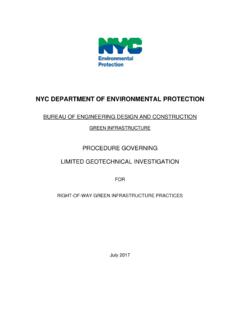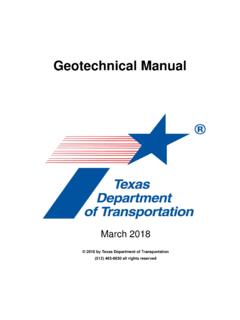Transcription of Geotechnical and Geophysical Evaluation Of Karst …
1 Geotechnical / Geophysical Evaluation OF Karst LIMESTONE SITES A CASE HISTORY Gregory B. Byer*, Prism GeoImaging, Inc., Fishers, IN John A. Mundell, Mundell & Associates, Inc., Indianapolis, IN John H. M. Vanderlaan*, Prism GeoImaging, Inc., Indianapolis, IN * Formerly of Mundell & Associates, Inc. Abstract A collaborative effort between a Geotechnical engineer and geophysicist in conducting subsurface evaluations of a Karst limestone site is demonstrated with this case history. The example shown here from southwest Missouri, demonstrates how the traditional Geotechnical approach to investigating Karst limestone sites can be adapted to embrace the use of geophysics. The site was found to contain active sinkholes, which were of potential concern to the engineer. Terrain conductivity, 2-dimensional resistivity imaging, drilling and downhole logging were combined effectively on this fast-moving and resource-limited project on a large acreage site.
2 In the case history presented, the Geophysical results were used as a guide by the Geotechnical engineer as he made decisions about recommendations for foundation design. The end result was the Geophysical information gave the Geotechnical engineer and his client what they wanted - greater assurance that they had exercised diligence in their efforts to define site conditions and avoid hazards. Introduction There are a number of Geophysical methods that have been tested and applied to the investigation of Karst limestone sites, albeit with varying degrees of effectiveness in achieving project objectives. To name a few, P-wave and S-wave refraction/reflection seismic, spectral analysis of surface waves (SASW), gravity, ground penetrating radar, 2D and 3D resistivity imaging, and electromagnetic conductivity have all been tested and evaluated with mixed results. In practice, the choices of methods available to a Geophysical consultant are often dictated by factors pertinent to clients such as cost, speed, method reliability, anomaly resolution, and data interpretability.
3 Confidence that the Geophysical survey will do a reasonable job in portraying site conditions is critical to the client, the consultant and their professional relationship. Ideally, Geophysical surveys should be conducted in a manner that guides the scope of the drilling portion of the engineer s subsurface investigation. However, in reality, the Geotechnical engineer will often seek the assistance of the geophysicist after an initial round of drilling has been completed, and after the potential risks associated with Karst are realized. Sometimes this realization can even come as late as the construction or post-construction phase when it is too late. The Geotechnical engineer is confronted with the ineffectiveness of the hunt and peck drilling method for mapping Karst features, especially at large sites. He/she approaches the geophysicist with a desire for increased confidence and reassurance that a reasonable effort has been made to define Karst features.
4 As such, the Geophysical methods chosen would be expected to provide a good indication of the depth to bedrock or at least the shape of the bedrock surface, variations in soil characteristics potentially effecting engineering design, fracture (pinnacle and grike) orientations, as well as the more critical features such as caves, voids, soil pipes, and sinkholes. The rationale for Geophysical method selection is certain to evoke debate among Geophysical professionals, as it is both a reflection of the consultant s education and experience, preferences and 1 motivations and the client s budget, schedule, and knowledge of, experience with, and/or opinions about, geophysics. Judging by the number of relevant papers and presentations over the last four or five years, it has become increasingly evident that the application of resistivity imaging, often combined with other methods, to Karst problems has gained wider acceptance.
5 For example, Roth et al. (1999) addressed the application of 2-dimensional resistivity in thinly mantled Karst at a scale appropriate to foundation design applications. Their application of 2-dimensional resistivity imaging as a guide to the selection of soil boring locations for a Geotechnical investigation proved valuable, although a number of limitations were noted. Because of the complex 3-dimensional nature of the site studied, it was evident that the 2-dimensional resistivity results often reflected the features outside the plane of cross-section. The obvious appeal for the application of 2-dimensional resistivity imagining is in its ability to provide a visually meaningful result to a non- Geophysical client that is a fair representation of subsurface conditions. Roth et al. (1999) points out that the advent of multi-electrode earth resistivity systems and the availability of 2-dimensional resistivity inversion modeling software have made the routine application of resistivity imaging feasible.
6 Zhou et al. (1999) conducted an extensive, gridded 2-dimensional resistivity imaging project consisting of 49 transects in a 10-acre area at a Karst limestone site in southern Indiana. Their method of determining the elevation of the top of bedrock yielded an average difference relative to borehole data of about meters, an excellent result. Despite this positive outcome, however, one clear downside to the approach used by Zhou et al. (1999) is the level of effort required to achieve the project objective. At an assumed rate of about seven transects per day, coverage of a 10-acre site would require about one week of field time. In addition, inversion and interpretation of a large number of transects would clearly require a significant amount of time as well, perhaps several weeks. We speculate that the time and cost for this level of effort might receive significant resistance from the client. The approach we present in this paper attempts to make the speed and cost of Karst investigation more desirable without significantly compromising the degree of coverage of the subsurface.
7 Technical Approach Our client, a Geotechnical engineer, through his prior investigative efforts, had already determined there was a need for a Geophysical survey. His investigations had established that sinkholes were present at the site and that an undulating bedrock surface was present, indicative of Karst activity. The technical approach used on the case history presented here is similar to the multi-step approach taken by others such as Ahmed and Carpenter (2001). It begins with reconnaissance mapping with terrain conductivity to form a basic understanding of the soil and bedrock relationships in terms of apparent conductivity or resistivity, preferably at a few depth levels. The interpretive emphasis is directed towards potential air or fluid filled voids and solution-enhanced features, such as grikes, which could contain underconsolidated soils ( , materials with high moisture content and low shear strength).
8 Interpretation of the terrain conductivity data is augmented with 2-dimensional resistivity imaging within the context of the interpreted terrain conductivity data. The next step is direct calibration of the Geophysical data. Drilling and sampling at key anomalies, combined with downhole Geophysical logging in the open borings, provides a link between the geologic observations and the surface Geophysical data. Finally, the terrain conductivity and 2-dimensional resistivity data are reprocessed and reinterpreted and a final geologic model is developed. This approach, applied to the subject site, and other sites, has proven to be a useful tool in the investigation of Karst limestone sites. It has been shown to be relatively rapid and cost effective while still providing a reasonable degree of assurance to the Geotechnical engineer that significant Karst features have been addressed.
9 2 Background Site Description The project site is located near the town of Republic, Missouri, a few minutes southwest of Springfield (Figure 1). At the time of the Geophysical investigation in 2000, the site was about 25 acres of overgrown, undeveloped land, which was undergoing initial site design for a future retail store. There is about Missouri 30 feet of relief across the site, and a valley sloping from the northwest to the southeast bisects the site. The valley is at St. Louis the head of a losing stream, and a well-defined sinkhole in the southeast corner of the site receives the surface run-off from the entire site. RepublicPrior investigations at the site by the Geotechnical engineer had included over 60 soil borings. Their findings indicated that the depth to bedrock was highly variable, ranging from the surface to over 20 feet (or more) in depth.
10 Concerns by the Geotechnical engineer pertained to both the highly irregular bedrock surface and the known existence of sinkholes. There was also concern about the possible existence of additional undiscovered sinkholes or incipient sinkholes just beginning to undergo formation. The Geotechnical engineer recommended to his client that a Geophysical investigation be conducted to locate Karst features before he would recommend site development. Site Geology Republic, Missouri is located in the Western Plains physiographic region, and the site is underlain by Mississippian age Burlington-Keokuk Limestone. The limestone is a light gray, coarsely crystalline, fossiliferous unit, highly susceptible to solution. A prominent feature of the bedrock is the formation of pinnacles and grikes, represented by prominent knobs (pinnacles) of bedrock bounded by deep troughs (grikes) caused by dissolution in fractures.







